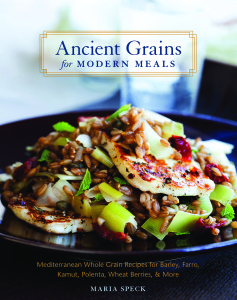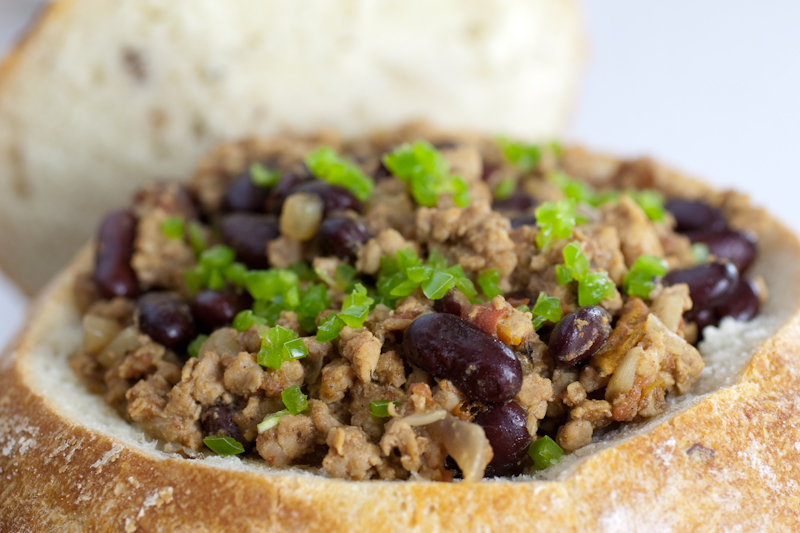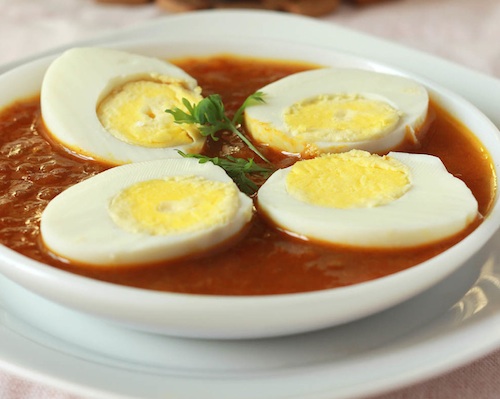Ancient Grains for Modern Meals
by Maria Speck (Ten Speed Press, 2011)
Let me start by saying that it took me many years to convert to eating brown rice (I converted only after I found brown basmati) and the only whole grain I used to eat was broken wheat (and yes, the occasional oatmeal). So when Maria Speck’s book landed on my doorstep, I was ready to give it a skip – me and whole grain? It was not a love affair that was going to happen.

I began to hear amazing reviews of the book and thought I needed to really open it and read it and cook from it. So I did and am I grateful.
The book is filled with recipes that wont scare you away. Speck is a inviting writer. I never thought I would actually say that I like whole grains but after making a few of her dishes, I think I may just convert.
What I like about the recipes is that they are fun without being silly and really show the author’s deep knowledge of food. You will learn how to make a leek salad with halloumi and rye berries, barley with crisped prosciutto and truffle oil, Wheat berry fools with Grand Marnier Figs…. all just delightful features.
I am pleased to feature the recipe that has possibly ignited my love of whole grains:
Creamy Farro with Honey-Roasted Grapes
“Reprinted with permission from Ancient Grains for Modern Meals by Maria Speck, copyright © 2011. Published by Ten Speed Press, a division of Random House, Inc.”
Photo credit: Sara Remington © 2011
farro
2 cups water
1 cup farro
1 teaspoon anise seeds
1 (1-inch) piece cinnamon stick
Pinch of fine sea salt
roasted grapes, and to finish
3 cups seedless red grapes (11/4 pounds)
1 teaspoon extra-virgin olive oil
4 tablespoons honey, plus extra for serving
1/2 cup heavy whipping cream or half-and-half
1/2 teaspoon vanilla extract
Ground cinnamon, for sprinkling
1 To prepare the farro, bring the water, farro, anise seeds, cinnamon stick, and salt to a boil in a heavy-bottomed 4-quart saucepan. Decrease the heat to maintain a simmer, cover, and cook until the farro is tender but still slightly chewy, 20 to 25 minutes. Remove the cinnamon stick, drain any remaining liquid, and return the farro to the saucepan.
2 Meanwhile, prepare the roasted grapes. Position a rack 6 inches from the heat source and preheat the broiler for 5 minutes. Spread the grapes on a large rimmed baking sheet. Drizzle with the olive oil and 2 tablespoons of the honey and toss to combine. Broil until the grapes just start to shrivel and release some juices as they burst, 5 to 7 minutes. Immediately transfer the grapes with their juices to a heatproof bowl.
3 To finish, add the cream and vanilla extract to the farro and bring to a boil over medium heat, stirring frequently. Cook until the cream thickens slightly, 3 to 5 minutes. Stir in the remaining 2 tablespoons honey, add the grapes with their juices and cook just long enough to reheat the fruit, about 2 minutes. Divide among bowls, sprinkle with cinnamon, and serve warm with more honey on the side.
to get a head start: Make the farro, as in step 1, ahead (see page 25). The grapes can also be roasted 1 day ahead. Chill, covered.
to vary it: If you like a bit more chewiness, try other berries from the wheat family such as spelt, Kamut, or soft whole wheat. You will need a scant 3 cups.



I’m sure there must be a lot of such grains used in Indian Cuisine as well, its just that it doesn’t get noticed, (until of course a high end chef decides to include it on a restaurant menu).
Yes, there are. I have never cooked with them since they are not something I am familiar with as my family never cooked with them. I used farro to make a pulao last week and it really rocked. I learned a lot from this book.
One of the most interesting grains I’ve been introduced to while living and working in India is dark pearl millet. I love its rich sweet aroma, and I have eaten countless bajra rotlas in Gujarati villages—surprising everyone as I took to them with such passion. I did ask for a little less ghee though which is poured on in abundance… Recently friends of ours recommended I try the tiny Indian ragi millet. I would love to! Its seeds are almost as small as Ethiopian teff which is to die for…
Monica, I too am discovering more unusual grains (or at least they’re unusual in my experience). I just love farro. I’m also enjoying quinoa now that I’ve learned that you have to rinse it very well to get rid of saponin, the bitter tasting coating that apparently serves as a natural insect repellant for the grain.
What’s really made me fall in love with grains though is the pressure cooker. With a pressure cooker, cooking grains is not the long process it can sometimes be. I know pressure cookers are commonly used in India, but I’m wondering if you have and use one, Monica?
I love my pressure cooker. Story on that soon .. thanks to you!! 🙂
What a delicious way to cook rice! I love the flavors in this recipe! I love the addition of grapes in the end. Yummy! Looks like this is an amazing cookbook. Must get my hands on it! Thanks for sharing.
Maria: As I was reading this, I started thingking about bajra as well as a really special whole grain that is absolutely delicious! I’m Gujarati and I have fond memories of my grandmothers feeding me bajra rotlas while I was growing up. I’ll have to learn how to make them–they really are something special!
Hi Tanvi,
Making bajra rotlas is really not difficult at all. They are indeed delectable. Obviously my Indian mother-in-law is the rotlo master in the family (she probably rolled out thousands over her lifetime), but I am very happy with mine. The most important is to locate freshly milled grain if you can. It will give you the best flavor. With a little patience, you will soon be a master too.